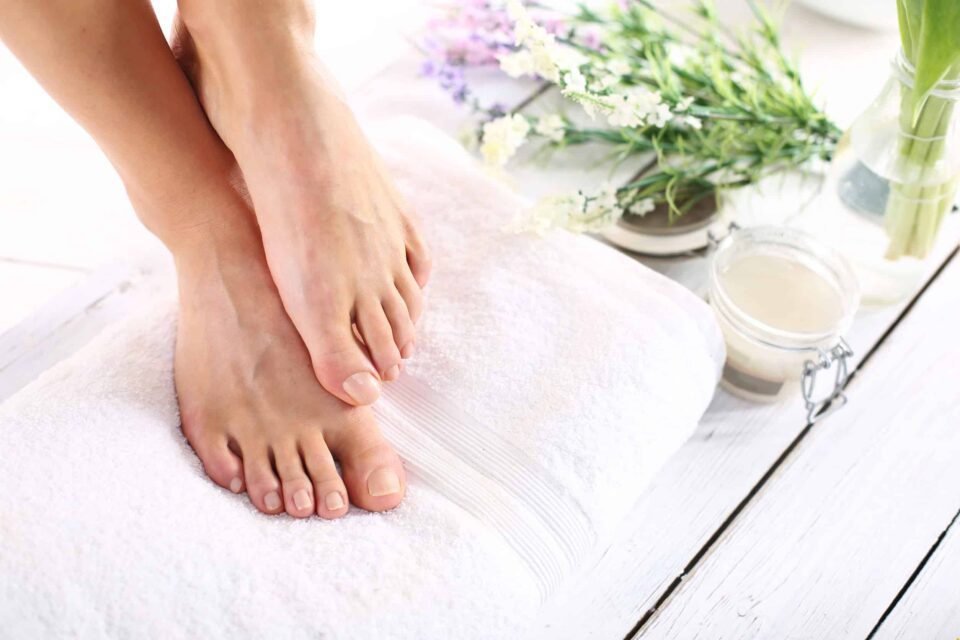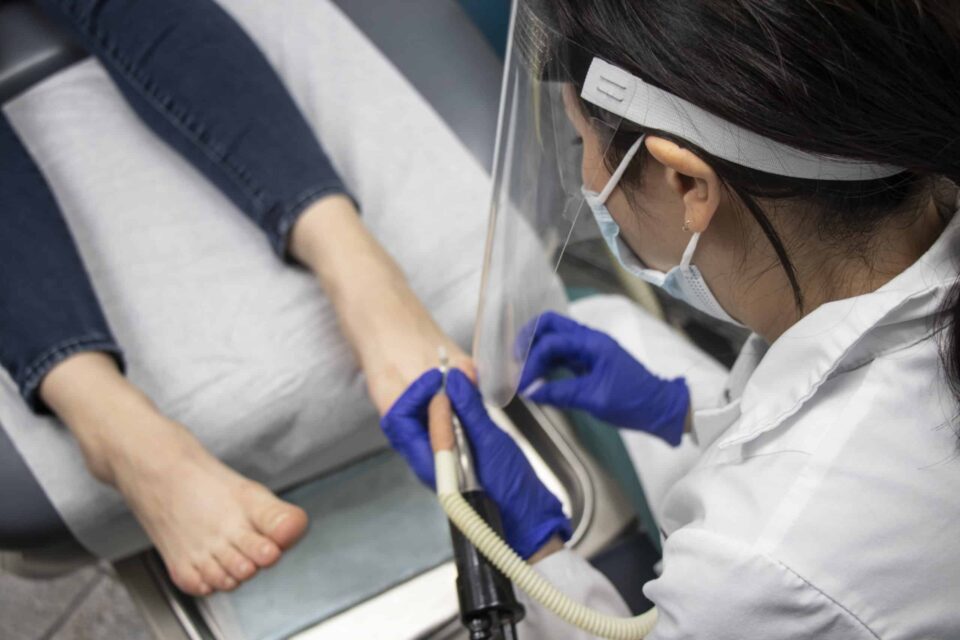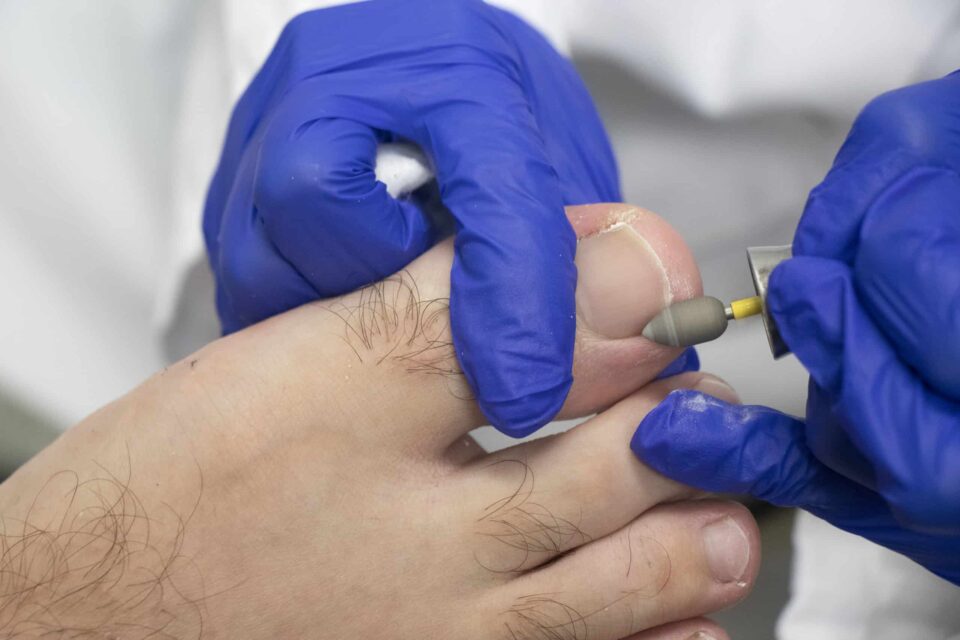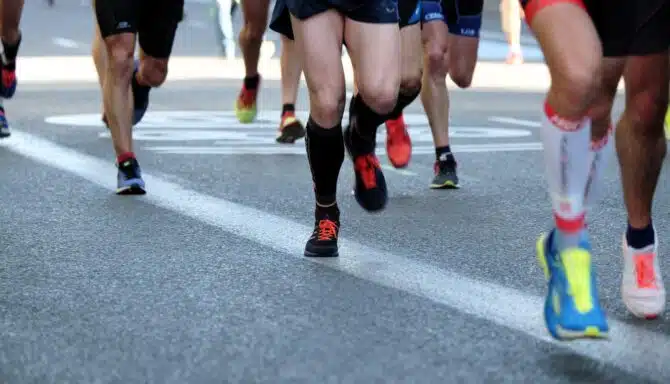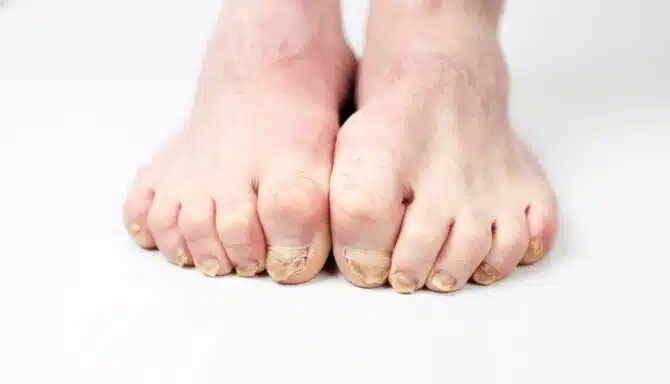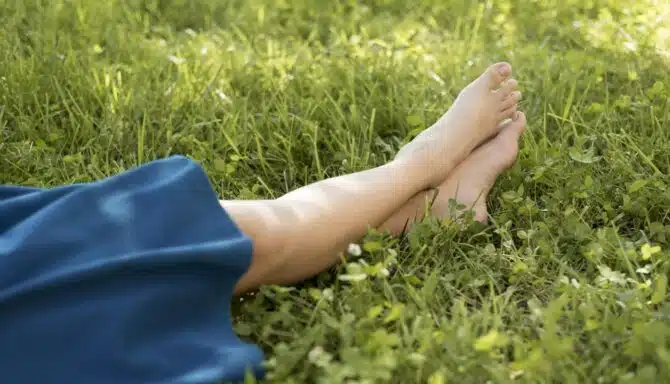July 24, 2025
Running is great for your overall health but your toenails might disagree. Many runners deal with painful or unsightly toenail problems, especially after long distances or hill training. Issues are so common that "runner's toenails" is a commonly used term to describe all the toenail damage. Understanding how running impacts toenail health can help you prevent injury and keep your feet in peak condition.
View this post on Instagram A post shared by Feet First Clinic (@feetfirstclinic_)
Common Toenail Issues Runners Experience
Black Toenail from Running (Subungual Hematoma): One of the most recognizable issues, a black toenail develops when repeated impact causes bruising or bleeding under the nail. It’s often due to shoes that are too tight or downhill running.
Toenail Lifting or Falling Off: Constant pressure on the nail bed can cause nails to lift or fall off completely, especially after a marathon or long run. This is usually painless, but it takes months for the nail to regrow.
Thick Toenails After Running: Repeated trauma can lead to thickened toenails, which may resemble fungal infections. This thickening is the nail’s response to long-term micro-damage and may become permanent if untreated.
Ingrown Toenails: Tight shoes or improper nail trimming can lead to ingrown toenails, which are common among runners and can become infected if ignored.
What Causes Running-Related Toenail Damage?
Improper shoe fit: Shoes that are too tight, too loose, or worn out can lead to friction and trauma.
Long toenails: Long nails hit the front of the shoe with every stride, increasing the risk of bruising or lifting.
Downhill running: Increases the impact on the toes.
Sweaty feet: Create a moist environment that can encourage fungal growth.
Inadequate socks: Thin or poorly fitted socks allow for extra movement inside the shoe.
Runner’s Toenail Care: Prevention Tips
Trim your nails regularly – Straight across, not too short, and never rounded at the corners.
Wear proper footwear – Choose shoes with about a thumb’s width of space at the front, and consider a running-specific fit.
Choose the right socks – Moisture-wicking and snug, with no bunching or seams that rub.
Replace shoes as needed – Most running shoes last 500–800 km. Worn-out soles contribute to poor foot mechanics.
Moisturize your feet – Prevent cracking and fungal buildup with a good daily foot care routine.
When to See a Foot Specialist
If your "runner's toenails" are persistently discoloured, painful, or thickened, it’s time for a professional assessment. What seems like a harmless black toenail from running could be a fungal infection, ingrown nail, or even an injury needing care. A chiropodist or foot specialist can safely treat nail trauma, provide custom foot care advice, and help you run pain-free.
View this post on Instagram A post shared by Feet First Clinic (@feetfirstclinic_)
Final Thought
You train hard so don’t let toenail trouble slow you down. By caring for your feet proactively, you can avoid common nail issues and keep running comfortably year-round.
April 10, 2025
Curved toenails can indicate various underlying toenail conditions, each with unique causes and additional characteristics. They also don’t always look the same. Toenail curvature issues can range from having a severe Ram’s Horn toenail, accompanied by other symptoms like thickening and discoloration, or small pincer nails that pierce your skin. Let’s learn about curved toenail causes, and most importantly, how a chiropodist or podiatrist can treat curved toenails at a foot clinic so complications don’t arise.
Why Do Toenails Curve?
https://www.youtube.com/shorts/Z6VYvI6CJQs
To understand the best ways of preventing curved toenails, it’s important to learn how healthy toenails grow. They should naturally grow forward in a slightly arched but mostly flat shape, following the contour of the toe. This process begins in the nail matrix, the tissue under the skin at the base of the nail, where specialized cells produce layers of keratin—the protein that makes up the nail.
As new cells form, older cells are pushed outward, harden, and form the visible nail plate. Ideally, the nail grows evenly and straight across, guided by both the shape of the matrix and the direction of mechanical forces applied to the toe, like walking or wearing shoes. The nail bed beneath provides support and helps keep the nail anchored and flat as it grows. A balance between nail thickness, width, and surrounding skin tension is key to maintaining this typical shape.
Toenails start to curve when something disrupts this balance.
Repetitive Trauma from Ill-Fitting Footwear
One common reason is uneven pressure and toe crowding. Tight footwear or repetitive trauma can push the nail’s edges downward or inward over time. That’s why one of the best ways of preventing curved toenails, or virtually all foot conditions for that matter, is purchasing and wearing only shoes that fit properly, allow your toes to splay comfortably, and have ample cushioning, arch support and shock absorption. It’s better to have a small selection of solid, high-quality shoes that support foot health than several pairs of low-quality, poorly designed shoes that cramp your toes.
https://www.youtube.com/shorts/rwNLRZ-MN_M
Genetics
Genetics also play a role in abnormal toenail growth; some people naturally have a more curved nail matrix or a narrower nail bed, both of which can encourage curling. If keratin production is uneven—say, one side of the nail grows faster than the other—the nail can begin to twist or curve as it extends.
Underlying Health Conditions
Inflammatory conditions, infections, poor circulation, or chronic diseases like diabetes can also interfere with normal nail growth by altering cell turnover in the matrix or causing changes to the skin and tissue around the nail. As a result, curved toenails are often not just a cosmetic issue—they can signal deeper structural or health-related concerns.
Curved Toenail Causes
Whether your curled toenails are the result of a sinister condition or simply a genetic growth pattern you’ve inherited, preventing them from getting worse is key. No matter the cause, proper trimming (straight across with simple nail clippers) and wearing shoes that fit well are two of the best things you can do from home to prevent painful complications and live life as comfortably as possible. Below you’ll find some of the most common causes of curved toenails:
Ingrown Toenails (Onychocryptosis)
Ingrown toenails are tricky as they look deceptively mild. But complications, like painful infections, can arise if you ignore them. They develop when the edge of a curved toenail grows into the surrounding skin, causing swelling, redness, and sensitivity. They can look curved, but they also look like a small “extra nail” on the edge of the main nail. It most commonly affects the big toe, and naturally curved toenails (involuted nails) are more likely to become ingrown because their growth pattern is already unusual.
Trimming the nails too short or rounding the edges can also encourage the skin to fold over the nail edge, allowing it to grow inward instead of outward. Repeated pressure or trauma from sports, stubbing the toe, or restrictive footwear (in the toe box, like narrow, pointed high heels) can also disrupt normal growth and set the stage for an ingrown nail to form.
https://www.youtube.com/shorts/B5a3yIgokh8
Pincer Nails (Trumpet Nails)
Classified by podiatrists and chiropodists as “the most painful type of ingrown toenail,” pincer nails, or trumpet nails, occur when the sides of the toenail curve inward toward each other, sometimes so dramatically that the edges look like they want to meet underneath the toe!
This shape creates a pinching effect on the nail bed and surrounding tissue. While some people are born with a naturally curved nail structure that gradually tightens over time, others develop this condition due to external pressures. Long-term use of tight shoes, particularly those with narrow toe boxes, is a major contributing factor. Certain systemic conditions, such as autoimmune disorders or circulatory problems, may also affect the nail matrix and contribute to this unusual curvature. Additionally, aging can play a role, as nail shape and growth patterns tend to change over time.
Onychogryphosis (Ram’s Horn Nails)
View this post on Instagram A post shared by Feet First Clinic (@feetfirstclinic_)
Onychogryphosis is a condition where the toenail becomes dramatically thickened and begins to grow in a distorted, curved, or spiraled shape that resembles a ram’s horn. It often affects the big toe and progresses gradually over time. The nail’s irregular growth is usually the result of uneven cell production in the nail matrix, where one side grows faster than the other.
The most common causes include repetitive trauma (like years of wearing ill-fitted shoes), long-standing fungal infections, or neglect of nail trimming. It’s more frequently seen in older adults or individuals with limited mobility who may struggle with basic foot care. Certain systemic conditions, including psoriasis and vascular disorders, may also interfere with healthy nail growth and lead to this thickened, curved form.
Curved Toenail Pain Relief and Solutions: Nail Disorder Treatment
Toenail curvature can cause pain and nagging discomfort that disrupts your daily life. Remember, the nail should not be growing this way, and it’s up to you to take the first step towards finding a solution. Chiropodists and podiatrists offer several effective treatments to address curved toenails, tailored to the severity and underlying causes. Below are some common treatments available at foot clinics:
Proper Fitting Footwear
Wearing shoes that are the correct length 0with a wide toe box is crucial for preventing and alleviating discomfort associated with curved toenails. Footwear that allows ample space for the toes reduces pressure on the toenails, minimizing the risk of them growing into the surrounding skin. Properly fitting shoes not only aid in preventing the development or worsening of curved toenails, but also provide some pain relief for existing conditions that need accommodation. Ensuring that shoes complement the natural shape of the foot without squeezing or compressing the toes is a simple yet effective measure in maintaining toenail health.
Medical Pedicures
Medical pedicures are performed by trained chiropodists or podiatrists and focus on the health and hygiene of the feet and nails. Unlike cosmetic pedicures, these procedures address underlying issues and focus more on nail maintenance and health than aesthetic appearances (although the nails always look clean and fresh afterwards!). During a medical pedicure, the specialist will carefully trim and reshape the toenails using sterilized instruments, reducing the risk of further complications.
They are a common treatment for people with diabetes who cannot cut and clean their nails properly without assistance, and who need an extra set of eyes and expertise to spot abnormalities.
OnyFix Nail Correction System
The OnyFix system is a non-invasive, highly innovative, and pain-free treatment designed to correct curved toenails—especially ingrown toenails. It involves applying a specialized composite material to the nail, which hardens and acts as a brace, guiding the nail to grow in its natural shape without exerting direct force. This method is suitable for various nail shapes and is particularly beneficial for patients seeking an alternative to surgical interventions. The Onyfix system allows individuals to continue their daily activities without restrictions, including swimming and wearing nail polish.
https://www.youtube.com/shorts/LoCcoKOhV7E
Nail Avulsion Surgery
In severe cases, such as with ram's horn toenail, surgical intervention may be recommended. This procedure involves the partial or complete removal of the affected toenail under local anesthesia. By removing the deformed nail, the underlying tissue can heal properly, and a healthier nail may regrow. Alternatively, a solution called phenol may be used to prevent nail regrowth.
November 30, 2024
Holiday shopping can feel like a daunting ordeal that takes away from all the fun. Your list is long, and you don't have ideas for some people - which is okay! But it doesn't have to cause so much stress. We've got you covered with our guide to the best foot care holiday gifts!
When you're stuck on what gift to get for your grandparents, friends, and other relatives, medical gifts may inspire you more than you realize. The health and wellness industry is known for producing excellent products, opening your mind to many gift options.
Gifts that promote foot health can help those with debilitating foot issues. But they can also help prevent foot conditions before they develop. And they're simply fun to use. We're talking foot creams, scrubs, and other luxurious products fit for a spa session!
The gifts we'll discuss today focus on both skincare and foot pain; they shine on their own and work well as stocking stuffers. But the best way to gift products from a foot care clinic is by compiling a foot care gift set! It's fun to try more than one product, and it gives loved ones the tools for a great self-care day. Let's take a look at our top picks!
Foot Care and Medical Gifts: Gift Guide 2024
Below is a general overview of our top foot care holiday gifts. But don't worry, we'll cover all the details.
Foot Exfoliators
Foot Creams & Moisturizers
Superfeet Insoles
Feet First Clinic Gift Certificates
Foot Exfoliators
Foot Scrubs & Foot Baths
Products like Gehwol's Herbal Bath are affordable medical gifts to raise your loved ones' foot care game to the next level. They're suitable for people of all ages and help exfoliate and soothe dry skin. Exfoliation prevents itchy, flaky dead skin from building up while simultaneously unclogging your pores. Exfoliating your feet weekly will help prevent and treat any callus buildup and cracked heels, while keeping your feet soft and moisturized.
But foot baths do even more for the body than you may realize. First, foot bath products combined with hot water help promote healthy blood flow, which can relieve pain from foot conditions like plantar fasciitis, bunions, etc. They can also warm your overall body temperature, which alleviates muscle tension, reduces stress, and may help prevent sickness or fight flu symptoms by strengthening your natural immunity (perfect for the winter!).
Helpful tip: It's best to start a spa session by bathing your feet, as it leaves a clean base for exfoliation and moisturizing by washing away bacteria and dirt.
Foot Files
Feet First Clinic's foot files are another great way to exfoliate your feet! You can gift someone a foot file as a stocking stuffer or as part of a gift box (throw in the Gehwol Herbal Foot Bath and some foot cream for the perfect foot care selection!).
But why do we need them?
Foot files remove hard, scaly dead skin from the bottom of the foot, making them feel silky smooth. Our foot files also have a smoothing side to buff and soften the skin. This allows you to customize and control where and how much skin you remove when exfoliating your feet (unlike the foot peels you see online). The perfect tool for concluding a luxurious at-home foot care session, you should give them some consideration as you shop for medical gifts.
View this post on Instagram
A post shared by Feet First Clinic (@feetfirstclinic_)
Foot Creams & Moisturizers
Gehwol Foot Creams
To restore the skin's natural barrier functions, you should always moisturize after soaking and exfoliating. Gehwol's Soft Feet Cream, Universal Foot Cream, and Med Lipidro Cream are just a few examples of medicinal moisturizers that work wonders. So why not gift them to someone you love? They'll get to enjoy smooth skin and fewer cracks and calluses.
If your loved one already has severely painful cracked heels, try gifting them Gehwol's Med Salve for Cracked Skin or Dermal Therapy Heel Care instead.
Dermal Therapy Heel Care
Hopefully, it's becoming clear that medical gifts can be more valuable than gifts that sit around collecting dust. And Dermal Therapy Heel Care is one of the best foot care holiday gifts around.
Cracked heels have the potential to burden everyone, from your best friend to your grandmother - dry skin doesn't discriminate! Severely cracked heels can make walking almost unbearable and cause swelling, inflammation, and bleeding. So if you're catching wind that someone you love is suffering, why not brighten their holidays by gifting them some relief?
Dermal Therapy helps skin cells deep below the surface absorb and lock in moisture, which fights cracked heels. It has the highest urea concentration (25%) of all the foot creams we carry. Urea is important because it works into the deeper layers of the skin to help skin both absorb and retain moisture. To top it off, dermal therapy is a moisturizer and exfoliator that removes dead cells, revealing fresh, young skin.
Superfeet Insoles
As far as medical gifts for healthy feet go, Superfeet insoles are a wonderful route to take. The general use of their most popular colour, green, is to provide extra support for people with flat feet, plantar fasciitis and other types of foot pain. And for those who want the same arch support as the flagship Superfeet Green, but with more cushioning and flexibility, you can get the Superfeet Run Cushion High Arch insoles - a new favourite and best seller at our Toronto foot clinic!
But if you have a loved one with more specific needs, worry not!
Superfeet produces several insoles with colours that indicate how they stand out. For example, Superfeet Berry is made specifically for women and comes with a slimmer heel and an arch length to fit the proportions of the female foot. And Superfeet Black is a versatile, low-profile option for people with flat feet. And that’s just the beginning!
October 24, 2024
There are two common fungal infections that can target your feet. For your skin, it’s athlete’s foot (tinea pedis), and for your nails, it’s fungal toenail (onychomycosis). Fun fact: Onychomycosis is the name for nail anatomy changes caused by contagious fungus, while dystrophic is the term for any other abnormalities that affect how your nails look or grow. Today’s blog will focus solely on toenail fungus. You’ll learn what it is and how to treat it, as well as some top fungal toenail prevention tips recommended by our Toronto chiropodists.
Toenail Fungus Symptoms
Sometimes toenail fungus is mild and barely noticeable. But fungal toenail can present more severely if you’re immunocompromised, such as if you have diabetes, or a senior. Keep an eye out for these common symptoms:
Drastic changes in the nail’s appearance: it can look much thicker, have a yellowish, brown colour, and be very brittle and prone to cracks, despite thickening.
Unpleasant odour coming from the nail: the smell is often reported to be sour or like cheese.
The nail starts lifting off the nail bed: this is because debris starts to accumulate and lifts the nail up so it can’t reattach.
Pain, swelling and bleeding in severe cases.
Toenail Fungus Prevention: Foot Specialist Advice
The most important fact to remember about fungal toenail is that it’s contagious. Since fungal infections spread easily in damp, shared spaces like pools, gyms, and shower rooms, the best defense is keeping your feet clean and protected! Here are some top, Toronto-chiropodist-recommended tips to remember:
Follow a strict, yet fun and relaxing, foot hygiene routine. It’s a part of self care, after all!
Wear breathable footwear. Opt for shoes made from materials that allow airflow to keep your feet dry.
Change socks daily. Fresh socks prevent moisture buildup, which fungi love.
Avoid going barefoot in public places. Use flip-flops or shower shoes to protect your feet in shared spaces.
Keep your toenails trimmed and clean. Regular maintenance helps prevent infections from taking hold. Get a professional medical pedicure if you don’t have time to focus on nail care.
How to Treat Toenail Fungus
Once fungus has gotten a hold of your nails, it’s time to think about treatment and eradicating the problem. Unfortunately, you can’t do much to treat toenail fungus yourself at home, and you often need a chiropodist’s help. Luckily, treatments are easy to follow and non-invasive. Here’s what a foot specialist can do:
Perform nail debridement to remove infected parts of the nail.
Use prescription-strength topical antifungal medicine on the nail (it penetrates the actual fungus)
Educate you on products you can use going forward to prevent re-infection, like the best moisture-wicking socks, shoes, foot creams, deodorants and more.
August 22, 2024
When it comes to foot problem prevention, being proactive is key to maintaining healthy feet and avoiding a future of discomfort. Understanding common foot issues and taking steps to prevent them can help reduce the risk of complications down the road.
In this article, we’ll explore five of the most common foot conditions and provide essential foot care tips to help you keep your feet in top shape.
Plantar Fasciitis
One in ten people will experience plantar fasciitis in their lifetime, making it one of the most common foot issues.
Plantar fasciitis at the start, can cause minor discomfort in the arch of the foot or even in the heel. It usually starts when you just get out of bed. It calms down through the day and then the soreness starts at the end of the day.
That discomfort, if not properly treated and investigated, can increase and then start to cause stronger and sharper pain. Sometimes this pain can last through the day to a point where you might find it difficult to walk. The main cause is inflammation- constant pulling and tugging on the thick, inelastic fascia itself (midfoot pain). Or, where it inserts from (the heel pain).
Pressure can be from the arch pressing down on the fascia:
It can also be a tight muscle, like the calf muscle pulling up behind the heel and forcing the fascia to pull away from the heel
It can also be a combination of a tight muscle and pulling of the fascia. In rare occasions plantar fasciitis is caused by a nerve entrapment.
Prevention
Preventing plantar fasciitis is mainly down to figuring out what was the cause in the first place. It might be a biomechanical issue with the feet. It could be due to the shoes that you might be wearing- at home, at work or just around town. In some cases it is due to a muscle imbalance. So figuring out the cause is the first step in treating and then preventing further plantar fascia pain in the future.
One of the cornerstone treatments in preventing plantar fasciitis involves prioritizing arch support! It is a good idea to wear supportive shoes with good arch support and shock absorption, especially if you spend long periods standing or walking. Custom or over-the-counter orthotic inserts can also provide extra arch support and cushioning to distribute pressure more evenly across your feet.
If you have a muscle imbalance then regular, targeted stretching of your calves and feet is also a healthy foot practice that can prevent foot ailments like plantar fasciitis.
Stretching the calves is especially helpful as it reduces strain on the plantar fascia. Check out the best exercises for plantar fasciitis. You can do your exercise routine before bed and when you wake up to prevent this painful condition from affecting your mornings.
Some patients have found rolling a tennis ball/ golf ball under their foot can be helpful to break up the inflammation to the area. Or rolling a wrapped frozen water bottle (no longer than 4 mins, then remove, wait to warm then walk) reduces inflammation build up
Athlete’s Foot
Athlete's foot can affect up to 15% of the global population!
It's a fungal infection that usually occurs on the skin between the toes. However it can also start and spread to the arches and then to the boarder of the foot. It can be itchy, red scaly looking and sometimes crack. Inbetween the toes the skin can look more damp than normal.
Prevention
Athletes foot is prevented if you reduce the causes. It enjoys dark, moist environments with an ample food supply. So your feet can be a perfect place for this to thrive. It can be contagious but also you can be more prone to catching it. So,
-if your feet are kept in a constant moist environment.
- you go to public pools and walk around barefooted.
- if you put your socks on right after having a bath or shower...
All these issues increase the risk of catching Athletes foot and allowing it to spread.
Prevention is linked to good foot hygiene. Therefore, make sure you wear slippers or flip-flops in public areas such as locker rooms or pools, and avoid walking barefoot in these places.
You should also make sure your feet stay clean and dry, as fungus thrives in moist environments. Opt for moisture-wicking socks, foot deodorants and breathable shoes. And never put on your shoes while your feet are damp!
If you are daily in the same shoes then try to use 2 pairs of shoes. Use one one day and one pair another day to allow the shoes to dry out. Change the insoles regularly.
Morton’s Neuroma
Some experts believe that one in three people will experience a Morton’s neuroma at some point.
It is characterized by a thickening of the tissue around the nerves inbetween the balls of toes (typically between the 3rd and 4th balls of the toes), and causes pain and discomfort in the ball of your foot.
You can get neuromas in other parts of the foot, but between the 3rd and 4th ball of the toes is called a Mortons neuroma
Prevention
Prevention is the best treatment for a Mortons Neuroma. Preventing the rubbing and thickening of the nerves is a priority. Unfortunately as the nerve thickens there is a chance that it will not go back to normal.
Preventing a neuroma is simply by wearing wider footwear in the toebox.
You can tell if it is your shoes just by removing the shoes and your soreness should subside.
Remember that work shoes, normal outdoor shoes and even slippers can all have an affect on compressing the toes together.
Having a heeled shoe puts more pressure upon the balls of your foot- so reducing arch height is also helpful (and if you must wear high heels, make sure they're the healthy kind!).
Custom orthotics can provide a way to splay the balls of the foot so even if the neuroma has thickened, it can reduce the pressure the balls of the foot are placing upon the nerves.
Ingrown Toenails
Our toenails can be a bit troublesome sometimes —they crack, curl, get too thick, and sometimes even surprise us with strange colours! But one of the most common toenail conditions is ingrown toenails. Two out of every ten people visiting a healthcare provider for a foot issue end up complaining about this painful nuisance.
Ingrown toenails can occur when a spike of nail is pressing into the skin. It can also happen if you have pincer like nails (involuted) and those nails press into the skin.
If you have wider nails, the skin on the side of your toe can be more prone to go into the nail. If the toes are kept in a damp environment then the skin and nails will be soft and more easily press into one another
Prevention
Prevention comes with finding the cause and preferable no home treatment (in many cases it can make it worse). Apart from scratching your socks, placing a "V" into the nail doesn't do anything.
Poor nail care is usually the main culprit especially cutting down the sides of the nail. It is better to allow the nail to grow past the skin line and then cut to the contour of the nail. Cutting straight across can leave angles and cutting down the sides can leave spikes of nail.
If your nails are curled around or thickened then professional footcare can help thin down the nail and offer treatments for the curved nail. Reducing dampness can reduce ingrown toenails. Wider footwear (and non tight socks) can reduce the risk of compressing the skin into the nail.
In some cases it can be hard to cut your nails effectively, if this is the case then having a medical pedicure from a professional is usually a good preventative option.
Calluses
Almost everyone will get at least a small foot callus in their lifetime and is a common foot issue.
They are thickened areas of skin that develop due to repeated friction or pressure. Initially they can be pain free but as time continues then the callus can build up and adds pressure that that area. This adds more callus and now a cycle starts.
Eventually too much pressure and the skin starts to break down and dry blood can appear within the skin.
Prevention
Callus is best treated by prevention- finding out why the hard skin is there in the first place.
So a footcare professional will look at your feet and assess where the hard skin is and then find the cause- where is that pressure coming from. They will then reduce down the hard skin, to break that pressure cycle, then offer advice on how to prevent the hard skin coming back- or reducing its build up.
In many cases this is due to poor fitting footwear or a mechanical issue with the foot.
Preventing callus build up can be done once a week with a plastic footfile when the foot is dry. Pumice stones are used when the foot is wet.
But it is usually a good idea to check the cause by a footcare professional as sometimes too much file or pumice use can make the area sore, affect the good skin surrounding the callus or even make the area worse as you might go too deep.
Dry skin is prevented where you moisturize your feet regularly (but not inbetween your toes).
It will also help the callus not crack but it won't prevent the callus build up- as that is caused through pressure.
August 5, 2024
Many people make it through their days without worrying about every little minor cut, scrape, ache or sensation. But for those with diabetes, foot care is a whole different ball game. Foot care for diabetes patients involves around-the-clock vigilance and solid diabetic foot care tips. These can prevent debilitating and life-altering diabetic foot complications, like severe mobility limitations, ulcers and even gangrene and limb loss. Let’s explore how a little goes a long way when it comes to foot health and diabetes.
Low-Impact Exercises and Stretches
Exercises and stretches that target diabetic neuropathy is one of the best strategies for protecting feet with diabetes.
To keep your feet as strong as possible, you need to stimulate blood flow and make sure nutrient-rich blood reaches your lower extremities. This can help wounds heal. Even if you have lost sensation in your feet, your muscles should still function properly enough to do light exercises.
Studies show that non-weight bearing and low-impact exercises and stretches can also improve motor score and help patients with activities of daily living (i.e.: basic chores, climbing stairs, etc).
To get started, check out the best exercises and stretches for diabetes.
Daily Inspections, Foot Hygiene and Nails
Preventing foot ulcers in diabetes patients involves frequently examining your own feet. A chiropodist should also do this for you, but more on that later!
Look at your feet multiple times per day. Are there any new wounds? Discolouration? Do your feet feel cold to the touch? Do you possibly have a fungal infection? Any abnormality should be noted.
Practice top-notch foot hygiene, as well. You can follow this general foot hygiene guide, but please note that diabetes patients are often advised not to cut their own toenails.
Schedule Regular Foot Assessments and Foot Care Services
At-home tips are great, but the truth is most diabetics need help managing foot issues. If you have diabetes, cutting your own toenails is often a bad idea because vision loss and neuropathy can cause you to not notice if you cut too deeply. Diabetes also affects the eyesight, so you may not notice any developing issues. And since diabetes causes circulation to the feet, these issues cannot properly heal. That's why one of the best services a chiropodist can perform is a medical pedicure that’s specially catered towards diabetes patients.
Your chiropodist can also:
Give advice on proper foot care. This often means investing in orthopedic footwear.
Provide wound care.
Assess for diabetic neuropathy — how severe is it?
Assess your blood circulation.
Inspect for potential ulcers.
If you live in the Greater Toronto Area, one of our Toronto chiropodists can perform routine diabetic foot care and diabetic foot assessments to help prevent diabetic foot complications. Click here to learn more about our foot care services for diabetes patients.
Additional Diabetic Foot Care Tips
Never go barefoot, even at home. Wear house shoes or orthopedic slippers. Being barefoot is too risky for diabetes patients, as if you stub your toe or cut yourself, the wound can't properly heal.
Avoid direct heat sources, like a really hot foot bath. It can dry out your skin and make your feet more susceptible to cracking.
Consider custom orthotics by learning when you might need them.

